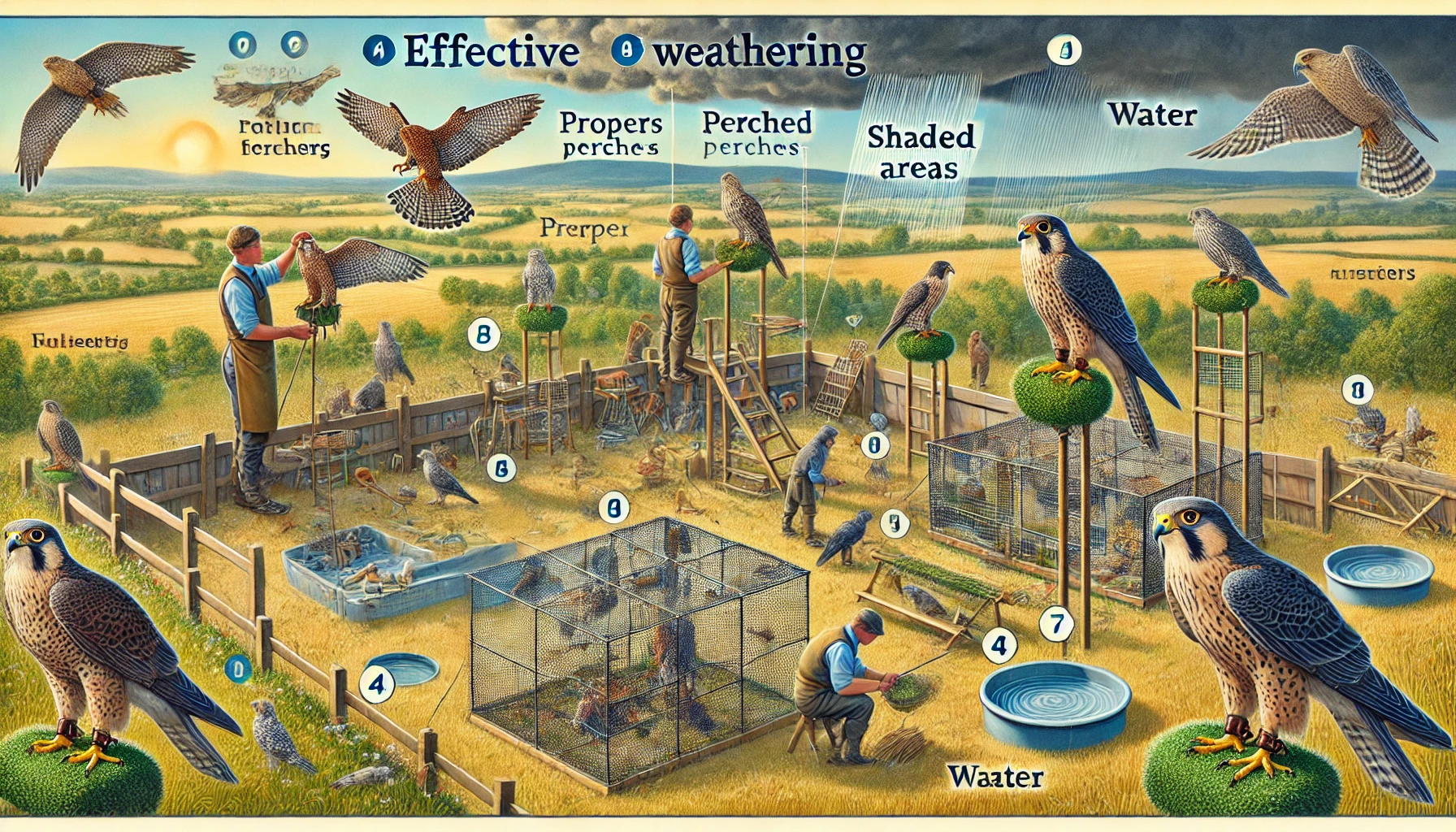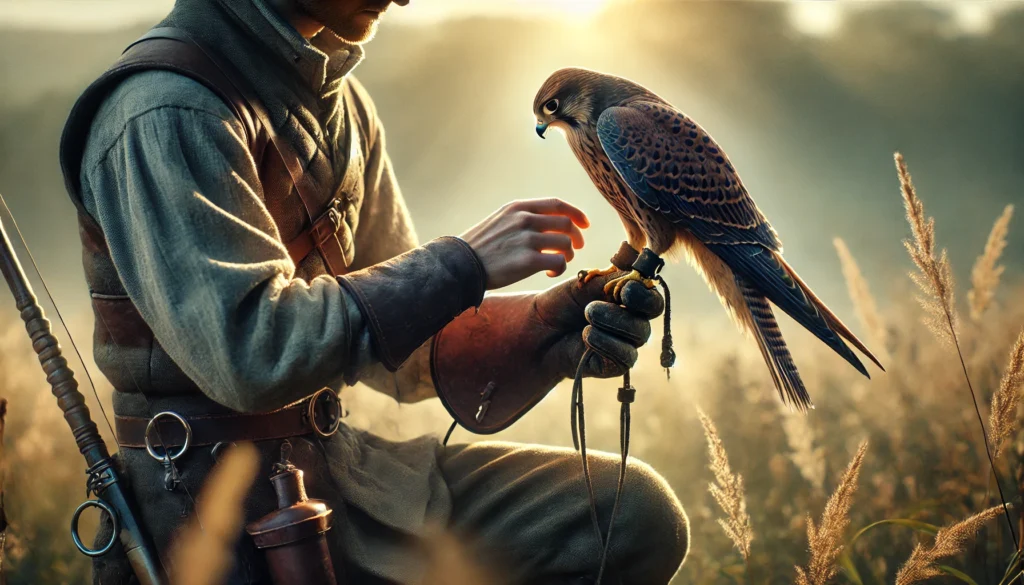Mastering Weathering Techniques in Falconry
- Understanding Weathering in Falconry:
- Weathering is a key aspect of falconry care.
- It involves exposing falcons to natural outdoor conditions to toughen them.
- Importance of Weathering:
- Helps birds acclimate to various weather conditions.
- Enhances their mental and physical health.
- Optimal Weathering Conditions:
- Ideal weathering happens in mild, dry weather.
- Provide sheltered areas to protect from extreme elements.
- Duration of Weathering:
- Initial short sessions of 30 minutes.
- Gradually increase to longer periods as the bird adapts.
- Safety Precautions:
- Secure birds with tethers to prevent escape.
- Avoid exposure during extreme temperatures or storms.
- Recognizing Signs of Stress:
- Watch for signs like excessive panting or lethargy.
- Return the bird to its enclosure if it shows stress.
- Health Benefits:
- Strengthens muscles and improves stamina.
- Promotes natural behaviors and reduces captivity-induced stress.
By following these weathering techniques, you ensure your falcon remains healthy, strong, and well-adjusted to various environmental conditions.
Discover the Art of Weathering Techniques in Falconry
Hello there, nature lovers and aspiring falconers! Have you ever wondered how the ancient art of falconry stays in tune with our ever-changing world? Just like Ireland’s weather can shift from sunny to rainy in a heartbeat, the practice of weathering in falconry is a dynamic dance that ensures your majestic birds remain in peak condition.
Weather plays a crucial role in shaping the bond between a falconer and their bird. That’s why understanding the best weathering techniques is not only fascinating but essential. Imagine this: Just like a finely tuned Irish fiddle, a well-weathered falcon performs with grace and precision, ready to dazzle onlookers and reach incredible heights.
In this article, we’re diving deep into the techniques that help keep our feathered friends safe, healthy, and happy. You’ll learn why it’s so important to pay attention to the environment and how small changes can make a huge difference. So grab a comfy chair and a warm cup of tea, and let’s embark on this enlightening journey together! Our unique insights and expert tips will transform your approach to weathering, making sure your bond with your bird is as strong as the cliffs of Moher. Keep reading, because every detail matters when it comes to mastering the art of falconry weathering!
Understanding Weathering Techniques for Falcons
Falconry is a time-honored tradition that requires skill, dedication, and knowledge. One essential aspect of falconry is “weathering,” which refers to the practice of acclimating a falcon to outdoor conditions. Whether you’re a beginner or a seasoned falconer, mastering various weathering techniques is crucial for your bird’s health and performance.
What is a Mews for a Falcon?
Before diving into the specific methods, it’s important to understand the role of the mews in falcon weathering. A mews is a specially designed enclosure where falcons live. It provides shelter, safety, and a controlled environment for the birds. You can learn more about setting up a mews by visiting our Mews and Housing page.
Different Weathering Methods
Weathering methods vary depending on factors such as climate, the species of the falcon, and the bird’s training level. Here are some common techniques:
- Outdoor Pavilions: These are open-air enclosures that allow falcons to experience weather conditions safely. The pavilions are equipped with perches and sometimes shade to protect the birds from extreme heat or cold.
- Indoor Weathering: In colder climates, indoor weathering may be necessary. This involves placing the falcon in a well-ventilated but sheltered part of the mews, ensuring they aren’t exposed to icy winds or dampness.
- Free-Standing Perches: This method allows the falcon to be tied to a perch outside the mews for short periods. It’s ideal for acclimating younger birds to the sounds and sights of the outdoors. Make sure you use appropriate jesses and leashes, found under our Jesses and Leashes section.
- Weathering Yards: These are large, enclosed areas where falcons can move about more freely while being safe from predators. A weathering yard mimics the natural environment, helping the birds build strength and conditioning.
Why is Weathering Important?
Weathering a falcon is not just about exposure to weather; it’s also about building the bird’s physical and psychological resilience. Proper weathering techniques help maintain a falcon’s feathers in pristine condition and keep them hydrated. It also makes the birds less likely to be stressed when taken out for hunts or training sessions. Discover more about maintaining your falcon’s health on our Falcon Health and Nutrition page.
Using Technology in Weathering
With advances in falconry technology, weathering can be monitored and controlled with greater precision. GPS trackers and telemetry devices can help you understand how your falcon reacts to different weather conditions. Check out our Innovations in Falconry Gear page for more details.
The Role of Culture and History
Weathering techniques have evolved over centuries and are deeply embedded in various cultures. For a richer understanding of the historical context, visit the History of Falconry section. You’ll find fascinating insights into how these practices were shaped by different regions and traditions.
Training and Weathering
Weathering is a key part of the training regimen for any falconer. Properly weathered falcons are more focused and better prepared for training sessions. To explore more about training techniques, visit our page on Training a Falcon.
Understanding and implementing effective weathering techniques is a cornerstone of successful falconry. By acclimating your falcon carefully and thoughtfully, you help ensure their well-being and readiness for the challenges ahead.
Advanced Falcon Weathering Techniques in 2024
In the world of falconry, the health and training of birds are greatly influenced by weather conditions. Understanding and utilizing advanced weathering techniques in 2024 is crucial for maintaining the well-being of falcons and other birds of prey. Let’s explore key aspects such as temperature, solar activity, and other atmospheric phenomena.
Temperature and Stratospheric Conditions
- On March 6, 2024, the Arctic stratosphere was monitored to be too warm for Type II polar stratospheric clouds.
- NASA’s MERRA-2 climate model helps predict when the air in the stratosphere will be cold enough for Polar Stratospheric Clouds (PSCs).
| Date | Temperature (°C) | Condition |
|---|---|---|
| March 6, 2024 | -20 | Too warm for Type II PSCs |
Solar Activity and Magnetic Storms
- On March 9, 2024, NOAA issued a minor geomagnetic storm watch (G1-class) due to an expected stream of solar wind affecting the Earth’s magnetic field.
| Date | Geomagnetic Storm Class | Expected Impact |
|---|---|---|
| March 9, 2024 | G1-class | Minor disruptions |
Cosmic Rays and Solar Cycle
- Solar Cycle 25 is intensifying, reflected in the number of cosmic rays entering Earth’s atmosphere.
- Neutron counts from the University of Oulu’s Sodankylä Geophysical Observatory have shown a gradual decline in cosmic rays due to the dynamic yin-yang relationship with the solar cycle.
| Year | Cosmic Ray Count (Neutrons/hr) |
|---|---|
| 2022 | 650 |
| 2023 | 600 |
| 2024 | 580 |
Aurora and Noctilucent Clouds
- The southern season for noctilucent clouds (NLCs) concluded on February 21, 2024.
- The appearance of the first NLCs in the northern hemisphere is anticipated around mid to late May within the Arctic Circle.
| Region | Noctilucent Cloud Activity |
|---|---|
| Southern Hemisphere | Season ended on February 21, 2024 |
| Northern Hemisphere | Expected start mid to late May 2024 |
Enhanced Weathering for Falconry
- Enhanced weathering involves artificial acceleration of natural weathering processes, using materials like finely ground silicates and carbonates.
- Aside from removing CO2 from the atmosphere, this method provides agricultural benefits such as improved crop yields.
| Technique | Benefits |
|---|---|
| Enhanced Weathering | CO2 removal, increased crop yields |
Falcon Weathering Methods
Some practical weathering techniques used for various purposes in 2024 include:
- Dry-brushing and acrylic washes for creating a worn appearance.
- Using oils, stickers, and powder to simulate natural wear and tear.
- Physical methods such as throwing or applying actual dirt for realistic weather effects.
| Weathering Technique | Method |
|---|---|
| Dry-brushing | Applying layers of paint for wear |
| Acrylic washes | Using diluted acrylics for texture |
| Oil ink weathering | Applying oil-based inks |
| Physical weathering | Throwing or hitting, applying actual dirt to simulate wear |
By understanding these specific weathering techniques and atmospheric conditions, we can better care for and train our falcons, ensuring their optimal performance and health in various environmental contexts.
Mastering Falcon Weathering Techniques in 2024
Weathering your falcon effectively is critical to maintaining the bird’s well-being and performance. In 2024, various environmental factors such as temperature, solar activity, and cosmic rays play an essential role. Key data points include:
- The intensity of Solar Cycle 25 impacts the number of cosmic rays, affecting stratospheric conditions and thus the birds.
- Specific pre-weathering methods and enhanced weathering techniques can create ideal environments for falcons, ensuring they remain healthy and active.
Advanced weather forecasting models and technologies are vital tools for falconers. They help predict changes in weather conditions that can impact the health of falcons. This includes using model outputs across different timeframes and regions to ensure accurate and reliable forecasts.
Understanding and adapting to these weathering techniques and tools will set you up for successful falconry, ensuring your bird thrives in various environments. The future of falconry lies in combining traditional practices with modern scientific insights, making 2024 an exciting year for the falconer community.



